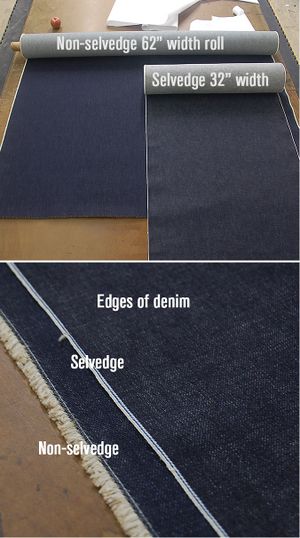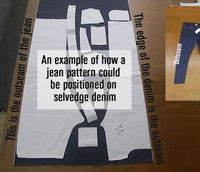Denim 101
page is under construction.
Contents
Selvedge and Raw
The two are often confused or conflated for one another, but "raw" and "selvedge" are two fundamentally different properties of denim (and, more broadly, of fabric). "Selvedge" refers to the type of fabric that the jeans are made of whereas "raw" denotes the unwashed state of the jeans. The telltale sign of jeans made with selvedge denim is the so-called "selvedge line" or white taping that runs down the outseam on the inside of a pair of jeans. Raw jeans, on the other hand, can be identified by their uniform, dark indigo color and the stiffness of their fabric.
Raw jeans don't have to be selvedge and selvedge jeans don't have to be raw. Furthermore, neither of these qualities necessarily denotes the quality of the denim. What, then, is the connection between the two and why are the terms so important?
First, let's talk a little more about selvedge.
Dry or Raw denim is denim fabric that is not washed during the production phase, after the color treatment process.
Selvage (or Selvedge, Self-edge) is a type of denim made on an old style shuttle loom which creates the unique edge that is typically used on the outseam of jeans. The result is a clean edge where the denim fabric is stitched together that can't be frayed like non-selvage jeans.
The shuttle looms which make selvage denim are smaller and produce fabric which is narrower (about 32”) than modern, wide projectile looms. Furthermore, the process tends to produce a tighter weave, requiring more material to produce an equivalent yardage. While this makes for a more appealing fabric, it costs more to produce, which is why many denim manufacturers switched to wider projectile looms in the mid to late 1900s.
Nowadays, most jeans are made using fabric produced on wide projectile looms. These looms produce more fabric more quickly and use less cotton per square yard. The fabric doesn't "complete" the way that selvedge fabric does, and thus the outseam needs to be sewn to prevent fraying.
None of this is to say that non selvedge fabric makes for "bad" jeans, but selvedge does make for a more authentic jean with a more visually appealing seam and more interesting fabric to the discerning viewer. Whether you're buying selvedge or non selvedge jeans, quality is often a reflection of cost, though. Expect to spend over $100 at retail for a decent pair whether or not you decide to buy a selvedge pair. Also note that the price difference between a selvedge and nonselvedge jean at this level might be completely negligible depending on the brand.
Why Buy Raw?
Simple. Buy an unwashed pair of denim and as you wear them more and more you watch the denim progress. Usually with denim like 7 for All Mankind and Rock and Republic, the denim goes through series of washing process to give it a worn look. Raw denim is unwashed before being sold. With wear, the denim loosens and fades which will form to your body. With every wear, creases will form and eventually indigo rubs off. The color will fade creating patterns. This is typical in higher stress areas such as whiskers (upper thigh creases), honeycombs (behind the knee creases), and down the thigh to the knee. You are creating what is seen on a typical wash on many designer jeans (since many washes try to mimic a natural fade).
Sanforization
Sanforizing the denim is the process of evening out the shrinkage and has no effect on the color or quality. When the denim is sanforized, it is already shrunk for you. Most denim now is sanforized so when you finally wash the denim it shouldn’t shrink that much. Some Japanese denim are unsanforized, they are shrink to fit. Unsanforized denim should be soaked BEFORE you wear them, that way you shrink them down ahead of time so you won't have uneven fades when you eventually wash them. Also, the denim will stretch with wear (less than 10%). Every brand is different.
Indigo Staining
Wearing raws can bleed some indigo with first couple of wears. Different jeans have different tendencies with the bleeding. Be careful wearing whites and light colors as they will stain. To keep them coming off your shoes, tape around the inside of the leg opening on the jeans to help eliminate the dye. You can try soaking the waist and leg opening with water to avoid the bleeding. If you already have indigo on your shoes or clothing, a simply wash should take it right out.
Washing & Soaking
There are several methods for washing. Most recommend if you wear your jeans constantly wait at least 6 months to wash them in hot water with detergent then hang dry them. Another method is to wear them into the ocean (not dirty oceans!) and then rinse them out with fresh (non salted) water and hang dry them. While you do not have to wait so long to wash your jeans, you will get the highest contrast fades if you wait since when you wash them the creases you created will be washed out and you might not get the creases in the same place, thus slowing down the fading. If your jeans aren’t that dirty, try soaking them instead. What does soaking do? Soaking cleans the denim, shrinks, and removes starch. Fill a bath tub full of water and lay the jeans inside out flat to float. Place bottles or something heavy on each leg and side to sink the jeans. The hotter the water, the more they will shrink. If your jeans aren’t that dirty but just stink, fabreeze them.
Hemming
Raw denim usually comes with very long inseams. If you have lots of stacking or unwanted length, it is suggested that you soak them to shrink and dry BEFORE HEMMING. Depending on the denim, you can lose 2 inches off the original inseam. While you wear the jeans for extended periods of time without washing, the creasing will eat up the inseam as well. So even if you soak or wash them before hemming, you should still allow an extra inch at least. Hemming by a professional tailor should be your last option. Stacking (taking all the extra length and pushing it down to your ankles to make them break and settle) or cuffing the hems are a nice alternative to hemming. It is not recommended to put jeans into dryer unless you want them to shrink radically and create wrinkles. Be advised the fit can possibly mess up in the dryer as well.
Under $100
- GAP
- Uniqlo
- Levis
- Cheap Monday
- Unbranded $78+, Made in Macau of Japanese denim
- J.Crew $96+
$100-200
- Gustin $99, Made in SF, USA of Japanese denim
- Williamsburg Garment Company $105+, Made in the USA and imported styles, Japanese denim
- April 77 $130+
- United Dry Stock Goods $135+ Made in USA of Japanese denim
- Naked and Famous $135+ ; Made in Canada, Japanese denim (Gilt often sells them for $89)
- Left Field NYC $175+ ; Made in the USA, Cone Mills denim
- Nudie $179+ made in Italy, denim from Italy, Japan, and Turkey
- APC $185+ Made in Macau, Japanese denim
- BLK DNM $190+
$200-300
- Edwin $200+ Made in Japan, Japanese denim
- ACNE $200+ Made in Turkey, Italy, Albania
- Rogue Territory $210+; Made in the USA; Nihon Menpu Mills denim, Cone Mills denim
- 3sixteen $215+ made in USA, Kuroki Mills denim, Japanese Denim
- Tellason $220+ made in USA, Cone Mills denim
- Levi's Vintage Clothing $250+ (for 501xx) Cone Mills denim, Made in USA
- Pure Blue Japan $275 Made in Japan, Japanese denim
$300&UP
- Momotaro $315+ Made in Japan, Japanese denim
- Roy $335+ Made in USA, Cone Mills denim
- Samurai $345+ Japanese denim, Made in Japan
- Iron Heart $360+ Made in Japan, Japanese denim
- Flat Head $335 Made in Japan, Japanese denim
- Dior $390+
Resources and Retailers:
Info
What is Selvedge Denim? a visual run down of selvedge and how it differs from non selvedge.
Rawr Denim, a great resource. Check out their "fade friday."
Selvedge Myth Busting. Take this info with a grain of salt.
Shops
Tate + Yoko (Canada)
Superdenim (UK)


